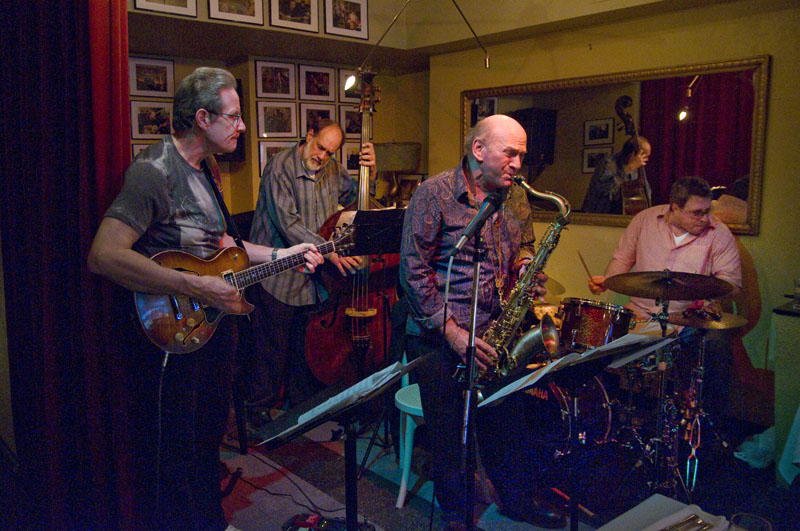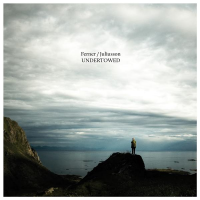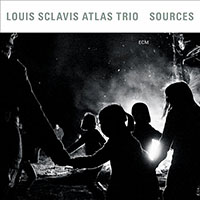Home » Jazz Articles » Book Review » Dave Liebman: What It Is - The Life of a Jazz Artist
Dave Liebman: What It Is - The Life of a Jazz Artist
 What It Is: The Life of a Jazz Artist
What It Is: The Life of a Jazz Artist Dave Liebman In Conversation with Lewis Porter
386 Pages
ISBN: 978-0810882034
Scarecrow Press
2012
In life, there's them that are aware and them's that ain't. Them's that are aware are not necessarily better than them's that ain't; but in being aware, they're able to assess their own lives in a broader context and, perhaps, as they reach the later stages of life, truly comprehend their strengths and weaknesses, their successes and failures, their achievements and the things that may simply be beyond their reach. An outspoken artist who, in refusing to suffer fools at all rather than just lightly, has undoubtedly made the occasional enemy along the way for telling it like it is, saxophonist Dave Liebman's accomplishments are many. The first of his generation to receive the National Endowment for the Arts' (NEA) Jazz Masters Fellowship in 2011—placing him alongside others who were seminal influences and, in some cases, employers or musical collaborators, including trumpeter Miles Davis, saxophonist Wayne Shorter and drummer Jack DeJohnette—Liebman has also been awarded France's Order of Arts and Letters, an honorary Doctorate of Music from the Sibelius Academy in Helskini, Finland, Grammy Award nominations and plenty of placements in year-end "best of" lists and polls, including All About Jazz for Best Live Shows 2011 and Best Releases in 2011, 2010, 2009, 2008 and 2007.
Even these accolades aren't sufficient to truly build a picture of an artist whose high-energy, no-holds-barred attitude may be all-Brooklyn, but whose compassion and appreciation is clear to any who have taken the time to get to know his career through his nearly countless recordings, live performances, interviews like an in- depth 2011 All About Jazz feature, and copious writings at his own website and in books like A Chromatic Approach to Jazz Harmony and Melody (Advance Music, 1991) and Self Portrait of a Jazz Artist (Advance Music, 1988). In a world flooded with saxophonists, it would still be a challenge to find one who has worn so many hats and adapted so successfully to as many styles. Folks would be equally hard- pressed to find one as hard-working; e-mails with Liebman almost always include the closing signature, "Lieb on the road."
Creating a full picture of who Liebman is and what he's accomplished is an ongoing and incremental process, where a great many pieces must be put together like a complex jigsaw puzzle, including keeping abreast of a travel schedule for recording, performing and education that would wither most musicians half the near-66 year-old saxophonist's age. Thankfully, What It Is: The Life of a Jazz Artist is a long- overdue career retrospective—albeit one of an artist who is still very much a work in progress—that helps bring all these pieces, if not exactly together, than at least on the same board where it's possible to draw a number of important conclusions. Rather than told in narrative style—either biographically or autobiographically— What It is is effectively a 386-page interview, conducted by Lewis Porter, whose John Coltrane: His Life and Music (University of Michigan Press, 2000) is (rightfully) considered the definitive book on the saxophonist whose spirit has loomed so large over Liebman's entire career. How Coltrane became a catalyst for Liebman comes relatively early in the book, and says plenty about Liebman in the process:
I didn't know it then or for decades, that there is more than meets the eye. This is a general statement that you can say about life, but in this case specifically, music. And even more specifically, jazz. This is not just some cats up there playing while you snap your fingers, move your body, groove, and have a good time, which is what I thought it was. This is everything you ever want to know. It's all the knowledge of the cosmos, of spiritual stuff, wherever you're at with that. It's just packed with information, feeling, humanity, life/death—the deal. And if it's the deal and it's there in front of you, you can't turn away from it. You are forced to have to find out what it is about.
It could have been a painting for somebody else. It could have been seeing an Ingmar Bergman movie. You get that hook, and that hook says to you, there's more. First, you think it's fun and all that. You move your fingers fast, and all that stuff I said about jazz in the beginning—Oh, it's so interesting, the guys, their eyes are closed, they don't talk to each other—how cool, how hip. But no, it's more, and this guy made me see there's more. I don't think without Trane that I would have gotten it. I mean, this is a big statement, but would I have gotten it through Miles Davis? Or Bill Evans? Or, you can name anybody, and I'm not sure because still today I haven't gotten it from anybody else. Trane covers that place for me. But would I have gotten it another way? I'm not sure. And if I wouldn't have gotten it, we wouldn't be sitting here. It's the truth. I would not have gone on with this music. I would have loved it, enjoyed it, but I would have done something else in life. I believe that. And I really put it to the beginning at that night in Birdland, New York City. That was the seed that turned into a tree.

Liebman gives plenty of space to his upbringing, including the polio that would, in many ways, define a personality driven by the resolve to surmount any and all obstacles. His matter-of-fact, conversational tone makes for a compelling read, because the entire book—beyond being filled with so many tremendous experiences and insider anecdotes—never feels dry or over-considered. Porter's injections, like those of the best interviewer, are there to help direct the conversation and, while his own accomplishments are many and admirable (something Liebman points out, more than once), it remains always about Liebman: his life, his experiences, his dreams, his accomplishments.
Throughout the book, Liebman generously ascribes so much of what has happened in his life to the actions of others—from his parents and early teachers to fellow musicians including, those seminal opportunities to work with drummer Elvin Jones and an album, Live at the Lighthouse (Blue Note, 1972), that has become a bona fide classic. His time with Miles Davis also gets plenty of footage—coming, as it did, during what was perhaps the densest and most unapproachable electric period of the trumpeter's career, on recordings like On the Corner (Columbia, 1972), which have only come to full appreciation decades later. It's not false humility, either; Liebman is quick to point out his own strengths, amongst them strong organizational skills and a work ethic that came, no doubt, from being an early baby boomer, born in post-WWII America and the first generation to actually have choices when it came to what they wanted to do with their lives. But Liebman's self-awareness is equally clear:
I was attracted to the notion of being an artist. It seemed so hip and different from what I knew—the mystery and voodoo of it. But I didn't know what that meant, though obviously it was different from what I had been brought up to believe. I was a what you see is what you get kind of person, quite meat and potatoes, though educated and highly curious. This art stuff was way beyond my purview.
Never denying the creative aspects of being an artist, what What It Is conveys most, perhaps, is the value of hard work. Liebman and Porter spend plenty of time talking about the loft scene of New York in the late 1960s/early 1970s and the Free Life Communication; playing with Jones and Davis; and, most importantly, the distinctive harmonic language that the saxophonist developed with Richie Beirach, one of a handful of pianists with whom Liebman has worked with again and again over the years, also including Marc Copland and Phil Markowitz.
His relationship with Beirach goes back the furthest, however; and if Liebman appreciates the significance and influence of the vernacular they have built together, beginning with Lookout Farm in the 1970s, through to Quest in the 1980s and 1990s, he's equally cognizant of the challenges endemic to any long-term relationship and how, as he approached 40—meeting his wife Caris and settling down to a more "normal" life with a house, a car, a child—some of those problems ultimately led to the dissolution of Quest, Liebman's drive to formalize and that language and, finally, a renewed relationship with Beirach in the last seven years with the reformation of Quest for occasional tours that have been documented on Redemption: Quest Live in Europe (HATology, 2007) and Re-Dial: Live in Hamburg (OutNote, 2010).
Liebman also spends plenty of time talking about his tireless efforts in the realm of jazz education—in particular, the International Association for Schools of Jazz (IASJ) that he founded, and considers to be the life's work for which he'll be most remembered, more than his contributions as a performer, a composer and a bandleader. That's certainly a topic for debate, but there's little doubt that Liebman has created, with his organizational skills and seemingly unrelenting drive, a means for truly keeping jazz alive and well. Liebman doesn't just talk the talk, he walks the walk, ensuring that high level jazz education continues to be accessible to students around the world in a way that focuses on the students and the music, rather than the act of education itself.

As a performer, another defining aspect to Liebman is his acknowledgment and, even more so, acceptance of jazz in Europe as being a different but absolutely valid beast—something that may stem from the American tradition, but possesses its own legs and a different approach. Collaborating with everyone from from Swedish bassist Lars Danielsson and pianist Bobo Stenson to the Italian quartet of Dream of Nite (Verve, 2007), with pianist Roberto Tarenzi, bassist Paolo Benedettini and drummer Tony Arco, rather than putting up barriers, Liebman's life has clearly been about breaking them down.
With a life like Liebman's, there's no shortage of anecdotes, from some surprising (but unsurprisingly astute and revelatory) comments about his collaboration with guitarist Pat Metheny on Elements: Water (Arkadia, 1999), to the challenges of being the only white player in Miles Davis' group at a time when "the colors of the Yamaha equipment on the stage were painted red, black, and green stripes, the flag of the Black Panthers." Liebman has never been shy to criticize, and has plenty to say about artists who sell out for a quick buck—while, at the same time, recognizing that were he offered a certain fee, he might do it too—but he's equally quick to turn that critical eye upon himself, in a manner that lends unequivocal credibility to everything he says. He's also quick to praise, and there's plenty of that, too, in particular about the members of his current Dave Liebman Group—guitarist Vic Juris, bassist Tony Marino and drummer Marko Marcinko.
And it's praise well-deserved, though it may be a stretch to think of Liebman the way he positions himself with the group:
Tony is very quiet. Vic reacts to Marko and it's great. I'm like kind of the outsider, 'cause I'm the old man.
In truth, a Dave Liebman Group gig—like his two-night stretch at Café Paradiso in Ottawa, Canada, in 2011—sounds, with eyes closed, like a group of younger players, because Liebman refuses do anything but keep on top of where the music is going, without ever losing touch with the foundations that make it what it is:
Each generation added something and I didn't want to get behind. Not a lot of guys from my generation do it that well. It's a way of hearing, and like anything, concepts come easier when you are young, meaning learning it when you are older is a challenge. I'm not going to tell you I'm as good as Steve Coleman is at it, or as my students, but I must say that at my ripe age I can get by with this crazy shit, more or less. Do I enjoy it as much and all that? That's a different discussion, an aesthetic one. But I want to be able to get on a gig and do it, not be just like—He only plays 'All the Things You Are.' I don't want to be the old man, you know. That's an ego thing, besides musical—you don't want to be typecast.
A confluence of confidence and humility—completely aware of what he's good at and where he needs work but, with the mind of a problem solver, always seemingly capable of addressing his challenges and moving forward—Liebman may be approaching septuagenarian status, but he still has plenty of plans and the energy, drive and work ethic to make them happen. Equal parts captivating autobiography and inspirational "you can do it too" guidebook, What It Is is just that. From Dave Liebman, you'd not expect anything less.
Photo Credits
Page 2: Dave Kaufman
Page 3: John R. Fowler
Tags
PREVIOUS / NEXT
Support All About Jazz
 All About Jazz has been a pillar of jazz since 1995, championing it as an art form and, more importantly, supporting the musicians who make it. Our enduring commitment has made "AAJ" one of the most culturally important websites of its kind, read by hundreds of thousands of fans, musicians and industry figures every month.
All About Jazz has been a pillar of jazz since 1995, championing it as an art form and, more importantly, supporting the musicians who make it. Our enduring commitment has made "AAJ" one of the most culturally important websites of its kind, read by hundreds of thousands of fans, musicians and industry figures every month.


























